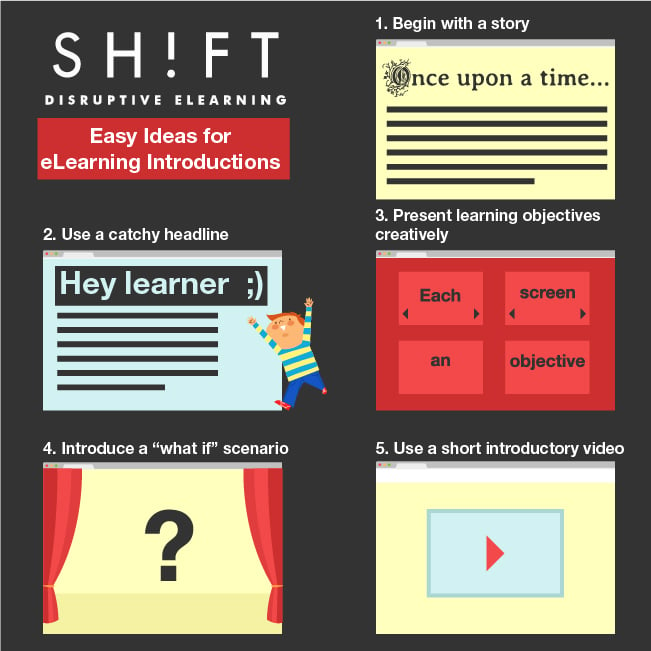It's easy to predict the success rate of a course just be looking at its introduction. If it's boring, learners would either skip it refuse to read it. Nonetheless, they're already convinced that the course is less than impressive.
And if it's not boring? Well, one obvious result of a lively, interesting eLearning course is better learner engagement. Every introduction, after all, makes a lasting first impression on students. Their initial perception will shape their long-term opinion of the course.
This carry over of first impressions is called the "halo effect, "where users search for confirming evidence and ignore evidence contrary to their initial impression".
That's why you have to be careful of how learners see your course for the first time. Do they find it trustworthy? Does the course make them feel welcomed? Does it look good? These are some of the questions you need to ask before publishing the introductory part of your course. If learners initially form a positive first impression, they will translate it to other areas of the course.
Here are some ways to create a positive first impression.

1) Begin With a Story
Storytelling is a powerful way to introduce a course. You can, for instance, show learners what the course is all about and how they can benefit from it by using characters they can identify with. A character that closely mirrors your learner's interests and wants can effectively capture his or her attention. This same character can play as an expert who guides and provides feedback to the learner.
Never underestimate the power of a believable character. A Caucasian coach who fluently speaks American English is a good match for American audiences but not for those in Asia.

2) Use a Catchy Headline
A headline or an introductory sentence is the most crucial part of your text. It is, unfortunately, one of the most overlooked element in an eLearning course. And it's easy to understand why.
For one, headlines are a bit difficult to write. This is partly because of the volume of data people get through various channels. They are too many articles on their newsfeed, too many tweets and social updates, and too many inboxes to sort and tackle. Also, it takes time to acquire the skill of grabbing attention through the headline. Even professional copywriters consider this multidisciplinary task challenging. On the Copyblogger blog, it was revealed that “on average, 8 out of 10 people will read headline copy, but only 2 out of 10 will read the rest.”
Now let's go back to your headline. Is it catchy enough to hold your learners' attention? Will it make them read your work? Take some time to rewrite and review your headings. Learners will use the headline to determine the relevance of your course, so it needs to communicate the main message in a way that will spark initial interest.
3) Get creative presenting learning objectives to the learner
A lot of eLearning professionals pay attention to the subject—or the “what” element—of the course objectives. But there's another equally important aspect they often ignore—the presentation of learning objectives. In other words, you should clearly spell out in your objectives what the student is expected to do with what they learn in the course, but present it in a creative manner.
A typical way of presentation is by listing all learning objectives as bullet points—which can be pretty boring. You can definitely go beyond that! There are many simple and effective ways to package or arrange such type of information creatively.
This SlideShare presentation gives you 51 ideas to introduce learning objectives creatively (though some apply only in face-to-face environments, many others can be applied to eLearning:
If you convey learning objectives in a more engaging way, and show learners how the module will help them become better at work or improve their mastery in something they love, then we will have truly taken a step toward making a successful course introduction.
Just be sure to emphasize an individual learner’s goals, not yours. Personalizing goals is a surefire way to get them excited about something. Skip writing about your credentials and personal history in the beginning. Focus, instead, on what you can give people through the module.
4) Introduce a "What If" Scenario
Imagine how learners would react to this introductory question:
What if you were able to learn a new skill and enhance your career?
Of course, you can specify what this new skill is depending on your audience and easily grab your learners' attention. So, instead of presenting a standard list of what you’ll learn ask them a question. Each time you ask a question, even if it is rhetorical, it conditions their brain to answer. This works because it immediately and emotionally appeals to learners.
5) Use a Short Introductory Video
Marketers are getting good results with short explainer videos on their landing pages. Videos definitely work on the beginning of an eLearning course too. They can quickly grab attention off the bat while making sure learners get more informed—and without being overwhelmed.




